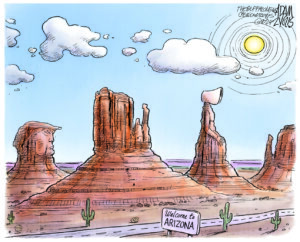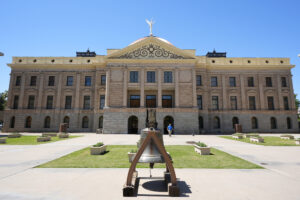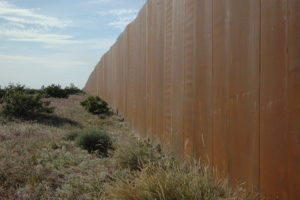Arizona Students Back in Class After Six-Day Teacher Strike
The state's educators win a 20-percent pay raise by 2020 after a walkout that was part of a bubbling national uprising over low pay and school funding.PHOENIX — Hundreds of thousands of Arizona schoolchildren returned to classes Friday a day after state lawmakers approved 20 percent raises for teachers and they ended a six-day walkout that shuttered most classrooms around the state.
Teachers at a high school in the Phoenix suburb of Mesa lined up to greet students with cheers and handshakes. An elementary school principal greeted students with high-fives on the other side of metro Phoenix.
Educators returning to work at San Marcos Elementary in the suburb of Chandler traded in their red protest T-shirts for shirts with their black and blue school colors and its bear mascot. Wearing sunglasses and smiles, they hugged and wrapped their arms around each other’s shoulders to start the day.
At Oakwood Elementary School in the Phoenix suburb of Peoria, Principal Shawn Duguid was dressed in a purple shirt in the spirit of one of the school’s colors. As he does every day, Duguid was in front of the campus gates before they opened to welcome the roughly 1,000 students between kindergarten and eighth-grade. Some parents came with boxes of doughnuts and other goodies for the faculty after the six-day absence.
Other parents, however, were still upset about the impact of teacher walkouts.
Charlene Schafer, who was dropping off her two sons, said she is “pretty ticked off.”
“They should have been in school. They were by themselves at home,” she said.
Terri Kiley, who was walking her daughter in, said she sympathizes with the teachers but wishes they could use other strategies.
“I understand what they’re trying to do. But I didn’t like that they shut down the school. Trying to get (the kids) re-motivated is a little rough.”
For 14-year-old Sariah Stone, finding motivation to get out of bed after six days off and no homework wasn’t the easiest.
“I thought I was on summer vacation,” the eighth-grader said.
Still, she is happy to be back. She missed “just being here, the daily routine. It just felt weird not coming back.”
Fifth-grade teacher Mechelle Kester was elated to be back on morning duty in the school’s drop-off zone.
“We missed our kids… They look like they’re still asleep but that’s OK,” Kester said with a laugh. “We’ll get them back on track.”
In Cindy Cordts’ third-grade class, children immediately sat down with a worksheet. Cordts warmly welcomed them back, briefly acknowledging the hiatus as “kind of like we had an extra spring break.”
“It’s very hard to put into words how excited I am to be back with my kiddoes,” said Cordts, who has been teaching for 33 years. “I have missed them absolutely greatly and we’re ready to finish the year strong.”
Strike organizers called for an end to the walkout Thursday after an all-night legislative session resulted in a 20 percent pay raise by 2020. Most districts planned to reopen Friday but Tucson’s largest district said it would resume classes next week.
“We will return to our schools, classrooms, and students knowing that we have achieved something truly historic,” said a joint statement issued by Arizona Education Association President Joe Thomas and National Education Association President Lily Eskelsen Garcia. “We should take pride in what we have accomplished, and in the movement that we have created together.”
The education funding plan approved by lawmakers shortly before dawn was immediately signed by Gov. Doug Ducey, awarding teachers a 9 percent raise in the fall and 5 percent in each of the next two years. Those increases, which are in addition to a 1 percent raise granted last year, will cost about $300 million for the coming year alone.
Ducey praised the legislation as “a real win” for both teachers and students.
The Arizona walkout was part of a bubbling national uprising over low teacher pay and funding. The movement started in West Virginia, where a strike resulted in a raise, and spread to Oklahoma, Kentucky and, most recently, Colorado.
Thomas said educators should now focus on a campaign for a November ballot measure that would seek more education funding from an income tax increase on the wealthiest taxpayers.
“The budget is a significant investment, but it falls far short” of what the movement demanded, he said.
Helen Hoffman, a counselor in the Phoenix Union High School District, said she was “excited” about the end of the strike.
“I’m worried about my students. I’m ready to go back,” she said.
Education cuts over the past decade have sliced deeply into Arizona’s public schools. Teachers wanted a return to pre-recession funding levels, regular raises, competitive pay for support staff and a pledge not to adopt any tax cuts until per-pupil funding reaches the national average.
The new funding package provides schools with a partial restoration of nearly $400 million in recession-era cuts, with a promise to restore the rest in five years. Other cuts remain in place.
Minority Democrats mainly voted against the budget plan, drawing criticism from Republicans.
“You know, talk is pretty cheap — it’s your vote that counts,” Republican Rep. Anthony Kern said. “If Republicans voted with Democrats tonight, you would be walking away with zero.”
Democratic Rep. Reginald Bolding urged lawmakers not to congratulate themselves for easing the same crisis they created.
“You can’t set a house on fire, call 911 and claim to be a hero. And that’s what this body has done,” Bolding said.
___
Associated Press writers Anita Snow, Paul Davenport and Bob Christie contributed to this report.
Your support matters…Independent journalism is under threat and overshadowed by heavily funded mainstream media.
You can help level the playing field. Become a member.
Your tax-deductible contribution keeps us digging beneath the headlines to give you thought-provoking, investigative reporting and analysis that unearths what's really happening- without compromise.
Give today to support our courageous, independent journalists.






You need to be a supporter to comment.
There are currently no responses to this article.
Be the first to respond.